In 1964, during my third year as a teacher in Sydney, I decided I wanted
to be a pilot in the RAAF. I went through all the tests, interviews and
finally the medical examinations. I remember that the chairman of the
interview panel was the charming Wng Cdr Knudsen who was at that time
the CO of the RAAF Academy at Point Cook. He was later known when
retired and over 60 years old, as a successful ultra-marathon
competitor on the north coast of NSW. Sadly, for me at least, my
eyesight was not good enough and I went for the alternative, to join the
RAAF as an education officer.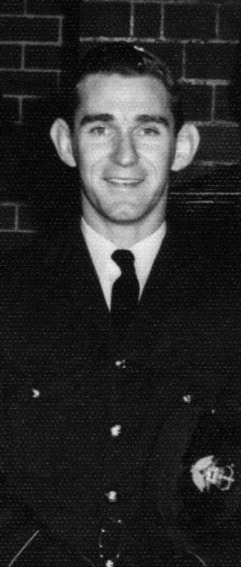
In December 1964 I found myself (that's
me in 1965, all decked out in my super duper 1A's) posted to Richmond awaiting an expected posting to Wagga to teach maths and
physics. There I was in the officers’ mess at Richmond a complete sprog.
They didn’t even have the correct size uniform trousers and told me to
wait till I got to my new posting to get a proper uniform. My first
breakfast was a fiasco. I didn’t know that I shouldn’t take my hat into
the dining room, but had left it out of the way in a corner. Soon a
steward excused himself and told me that Wng Cdr Timms (CO of 2AD) would
like to speak to me.
‘You brought your hat into the dining room!’ he accused. ‘Yes sir’ I
replied and explained that I didn’t know what to do. After breakfast a
flustered mess secretary cornered me and told me off. It seems that
Timms had stern words with him for not helping this sprog. I was
criticised for having a new shirt which looked new! I was given an iron
and ironing board and told to get rid of the creases.
Anyway, my new posting came through and I was shocked to see that I was
off to Laverton and the School of Radio. Didn’t these people know I
knew absolutely nothing about electronics? Later in December I stepped
off the railway platform at Laverton and made my way across the highway to
the front gate, past the old Meteor. Suddenly I heard and saw something
that really surprised
me, a U-2 took off and spiralled ever upwards over
the hangars at 1 AD. I was, in time, to become friendly with the U-2
pilots in the mess. More of that in coming issues.
The next morning I found myself at Radschool meeting OICTF (Officer in
Charge of Training Flight), Sqn Ldr Dennis Bolam RAF.
‘Pilot Officer Alley, what qualifications in radio do you have?’ ‘None
sir’.
‘Any experience in radio?’ ‘None sir’.
‘What do you know about radio?’ ‘Nothing sir’.
‘Interested in radio?’ ‘No sir’
I wonder what he must have thought of me. The year that followed was one
of the most exciting of my life. The course I was due to take had
already started without me, being taught by Flt Lt Brian Doulis, who it
seems was not a particularly good teacher. The troops were pleased to
get a teacher even though he knew bugger all about radio. So I put my
head down and learnt all I could. I was lucky to be taken under the wing
of Flt Lt Jack Saunderson who had been an NCO Radtech in a former life.
Jack taught me the practical aspects of radio and I preferred to do the
lab classes with the troops instead of just sending them off to Nick
Carter or Ivan Spiller.
In that first year I got to teach all the courses up to and including
Rad 6 (Pulse Techniques) and thoroughly enjoyed myself. As a trained
teacher I was somewhat against the idea that students could learn 8
hours of radio in 8 hours of classes. Clearly the people running the
place knew nothing about educational theory. Those of you who may have
been my students will remember that we had periodic class discussions in
which we would argue the toss over many subjects. This was to finally
get me into a little strife because some do-gooder spread the word that
I was a communist! More about that later. I believe the discussions
(arguments) helped with logical thinking and I am happy to say that
after 3 years at Radschool I had only one student fail an examination.
This bloke deliberately failed because he wanted to re-muster to General
Hand as (he thought) that would give him more of a chance to be gunner
on a helicopter. Perhaps he was keen on killing.
I must digress here and tell of my experience at OTS (Officers Training
School), which was three months from January 1965. Here we learned
‘couth and culture’. There were 2 other education officers on the course
and all three of us were considered to be not quite up to scratch. We
had the bad habit of questioning authority. The other two went and
became navigators and I went back to Radschool. The highlight of those 3
months was meeting a guy who had been a mid-upper gunner on Lancasters
during the war. He had flown on the Dresden raid and said that you could
see the fires soon after take-off over England. He also remembered
seeing the ME 262’s and said that he couldn’t traverse his guns fast
enough to keep track of their movement across the sky. It was an
interesting time in the RAAF because some of the old shell-backs were
still around and had amazing stories to tell.
At OTS we were required to write an essay which would be assessed on its
literary merit, or so we were told. I was an innocent amongst
barbarians. My topic was the North-west Cape US navy communications
station, the one which would give the signal to go to war to US Polaris
missile submarines in the Indian Ocean. I suggested that such an
establishment made Australia a nuclear target for nuclear missile
carrying Russian submarines. Well, I was rapped over the knuckles for
that. Since those times such a belief has been widely held, but I was
perhaps a little too far ahead of the times.
By the second year at Radschool I was no longer teaching RAD 1 to 5, but was
exclusively teaching Pulse Techniques, Radar, and Control Techniques. As
always I plagued the experienced guys for practical applications and
stories. The signallers had a couple of officers who had flown on ASW
aircraft (Neptunes etc…) and one of them, I think his name was Moody,
had flown on Shackletons with the RAF. He had hair-raising stories to
tell about a particularly Shack captain he flew with who seems to have
been a crazy. This guy actually flew at 50 feet in fog through a Russian
naval exercise! He dropped an active sonobuoy (still secret at that
time) into the water above where a Russian submarine was in some
national waters. The submarine surfaced, picked up the sonobuoy and
submerged. This was of course during the time of the ‘cold war’.
One of the ex-signallers got the key to A89-301, a Neptune out of
airframe hours and parked outside 1AD. He showed me over the thing and
from then on I would take my Radar students for a similar excursion.
What a fabulous teaching aid!
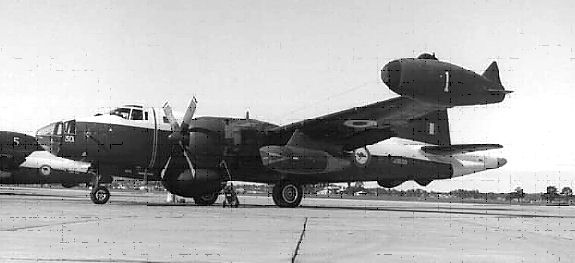
In the picture to the left you can see the APS 20 (belly pod), APS 31,
(left wing pod) MAD (Magnetic Anomaly Detector, the sting at the back) and the ECM antenna covers. The starboard wingtip
housed the searchlight. You will note the line down the fuselage showing
when the big prop would be rotating. Apparently when the engines were
turned off after a full stop, the big prop would continue to turn. At
Richmond an LAC forgot and they found pieces of the poor man scattered
over some distance. The rule for the aircrew when coming down through
the hatch was to walk forward and touch the nose wheel. I believe this
aircraft ended its days as a subject to be destroyed in training fire
crews. It started its life as a bomber with a gun turret on top and
underwent many upgrades such as the fitting of the Westinghouse jet
engines.
After a relatively short time I got to know the U-2 pilots. They were
not your run of the mill steely blue eyes. All were very experienced,
not so young and I would say well educated. One of them used to play
classical music on the mess piano. I got to know Major Pat Halloran, a
charming guy who took me down to the 1AD hangar to watch the preparation
for the day’s flight. The pilot was actually interviewed by a doctor and
given an examination. Then after he had all his suits on, but not
wearing his space helmet he was helped to a vehicle where he was driven
to the aircraft. After they got him settled into the cockpit, the
faceplate of the helmet was put on and he sat there breathing pure
oxygen for 20 minutes to expel any nitrogen that might be in his blood.
After all, he was about to ascend at a high rate and there was the
danger of bends, suffered by unlucky divers.
The U-2, which was built by
Lockheed, had two inline wheels under the fuselage and 2
detachable outrigger wheels on the wing tips. All fuel was carried in
the wings because the thing was really just a huge engine with a cockpit
and wings attached. The same engine was used in the F-104 Starfighters
(widow makers). Engine started, a lot of bloody noise and the thing taxis with two airmen walking alongside the outrigger
wheels. At the threshold of the runway, the airmen take the outriggers
off and hold a wingtip each. Full power, brakes off and the two airmen
run like hell holding the wingtips until it can be kept straight and
level. And then it just spirals straight up and disappears. About 5
hours later the U-2 returns. They had no fuel gauges and so the pilot
had to distribute fuel from each wing by feel and balance. Because they
are gliders they are actually difficult to get back down after the fuel
tanks are depleted. The pilot has no downward and very little forward
vision and necessitates another U-2 pilot in the control tower to ‘talk
him down’. Remember, no wheels on the wings. These crème de la crème
pilots were able to land the aircraft, taxi it to dispersal and a wing
tip would slowly drop to the ground. Hence the need to balance the fuel
use.
and the thing taxis with two airmen walking alongside the outrigger
wheels. At the threshold of the runway, the airmen take the outriggers
off and hold a wingtip each. Full power, brakes off and the two airmen
run like hell holding the wingtips until it can be kept straight and
level. And then it just spirals straight up and disappears. About 5
hours later the U-2 returns. They had no fuel gauges and so the pilot
had to distribute fuel from each wing by feel and balance. Because they
are gliders they are actually difficult to get back down after the fuel
tanks are depleted. The pilot has no downward and very little forward
vision and necessitates another U-2 pilot in the control tower to ‘talk
him down’. Remember, no wheels on the wings. These crème de la crème
pilots were able to land the aircraft, taxi it to dispersal and a wing
tip would slowly drop to the ground. Hence the need to balance the fuel
use.
Pat Halloran had been one of the U-2 pilots who flew the spy missions
over Cuba during the missile crisis. He retired as a general.
Remember the unit parades every Tuesday morning? We officers would line
up hoping to be a supernumery and not have to lead a flight of troops,
but sometimes I would be unlucky and find myself at the front. So there
we go, marching towards the saluting base with Bon Hall (Wng Cdr) taking
the salute. I would give the ‘eyes right’ order and march on all alone
out there. After one march pass I found that the flight marker slowed
down and the flight finished up over 20 yards behind me. Aaahhhh,
sprogs! The next time, as I was giving the order the ‘quick march’ I
said out of the corner of my mouth ‘keep up this time’. OK, I asked for
it, they stayed within one yard of me during the march past!!!! I could
hear them breathing down my neck. At least they weren’t carrying rifles
and bayonets, heaven forbid.
Which brings me to a passing out parade, in more ways than one. I think
it was April when the first course of AEO’s (Air Electronic Officers)
graduated. We were in winter uniform and it was a warmish day. There I
was in 1A’s with gloves and sword and in front of a flight of troop with
muskets and bayonets. Some Air Vice Marshall made the presentations and
gave a speech, finished and then thought better of it and went on
talking. It was hot, we were all sweating and then I heard
it…clatter….groan…thump behind me. Helpers from the side of the parade
ground rushed on and carried the ‘body’ away for treatment. It was
infectious and they started going down all over the place. We had to do
the ‘review in advance order’ and found ourself marching the 15 paces
forward, ready to salute and present arms, stepping over bodies and
fallen rifles. What a shambles. But it really was bloody funny!
I was unlucky enough to be in charge of a block of living quarters and
had to do those inspections after each parade, with a senior NCO escort.
You all no doubt remember those annoying words ‘re-panic!’.
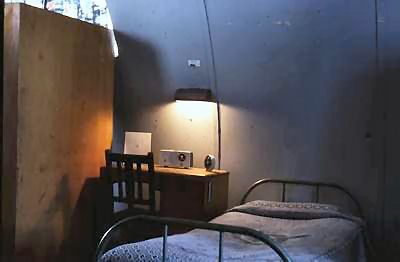 At one
period there seemed to be a bunch of new guys who were a bit of trouble
and it was rumoured that they had connections with some crims in
Melbourne. I appointed their ‘leader’ as block orderly. Never again did
I have to use the word ‘re-panic’! My worst moment was having to do a
kit inspection of a troop who had been complained about. He apparently
wasn’t washing himself or his clothes. I was embarrassed.
At one
period there seemed to be a bunch of new guys who were a bit of trouble
and it was rumoured that they had connections with some crims in
Melbourne. I appointed their ‘leader’ as block orderly. Never again did
I have to use the word ‘re-panic’! My worst moment was having to do a
kit inspection of a troop who had been complained about. He apparently
wasn’t washing himself or his clothes. I was embarrassed.
One week I saw air force justice at its most savage. Some students
clearly had a dislike for Ivan Spiller, who really was a stickler for
rules. One Radmech wrote some insulting comments about Ivan on a lab
report. Ivan naturally took offence and showed the script to his boss
and up the line it went. By that afternoon the Radmech was given a
Radmech trade test, failed it, was remustered to general hand and found
himself on the end of a broom in hangar at Richmond, later that
afternoon. I think the details are correct, but in essence that is what
happened.
One morning during a break in the lessons, one of the troops looked
really happy and seemed to be bubbling with glee. I asked him what was
going on. He told me his brother had just been promoted to Captain. Zanko Barbadin’s brother was a fighter pilot in the Russian
air force! Zanko was as Aussie as they come, but I saw the chance to have a bit of
fun with the unit CIO (Counter Intelligence Officer) who was inclined to
take himself rather seriously. Wickedly I told the CIO about the
security problem we had and he frothed at the mouth and luckily nothing
came of it.
Every so often, routinely we had to take the OO armband for a day and be
Orderly Officer. You would be on edge all day and night. For years after
I left the RAAF, I couldn’t bear the sound of a telephone. At 10 PM,
close the airmen’s boozer and try to avoid the drunks. At 11 PM, go to
the corporals’ club and lock the beer gun away, but we knew they had a
second beer gun hidden from the orderly officer. And of course, never go
near the sergeants’ mess, strictly off limits. I didn’t have a lot of
time for the service police and had the pleasure one night of walking
into the corporals’ club and finding two spits with cards and money on
the table. Boy, did they look sheepish, so I went outside for 5 minutes,
went back in and lo and behold, a clear table. The phone rings at 3 AM
one winter’s morning, go down to the guardhouse and lock up some poor
bugger who had been AWL for 350 days. They picked him up in Perth. I
took his belt and shoe laces off him.
Our greatest fear was an aircraft
crash. Even an AOG (aircraft operationally grounded) was big trouble for the
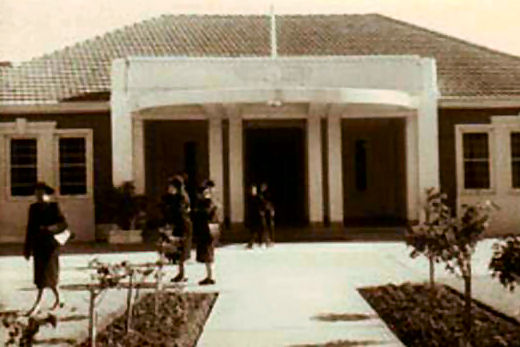 OO. One night in the mess,
phone rings, steward answers it and calls ‘Orderly Officer’, take the
phone. A lady is complaining about the sonic booms over her farm because
the sound is upsetting the chooks, the cows and her husband, in that
order. As luck would have it, a test pilot was drinking next to where I
was standing ‘I think this is for you’ says I. Hand him the phone and
listen to a cock and bull story about the defence of the nation and
patriotism. It seemed to do the trick. The only advantage the OO got was
the special treatment from the stewards and mess staff. There are
strange rules in the mess, such as coffee must be consumed in the
ante-room, never in the dining room. Except for the OO, who had his
coffee brought to him by a steward.
OO. One night in the mess,
phone rings, steward answers it and calls ‘Orderly Officer’, take the
phone. A lady is complaining about the sonic booms over her farm because
the sound is upsetting the chooks, the cows and her husband, in that
order. As luck would have it, a test pilot was drinking next to where I
was standing ‘I think this is for you’ says I. Hand him the phone and
listen to a cock and bull story about the defence of the nation and
patriotism. It seemed to do the trick. The only advantage the OO got was
the special treatment from the stewards and mess staff. There are
strange rules in the mess, such as coffee must be consumed in the
ante-room, never in the dining room. Except for the OO, who had his
coffee brought to him by a steward.
Naval officers would never speak in the morning until they had finished in
the dining room and had drunk their coffee. Then you would get a
response if you said ‘good morning’ to one of them. Army officers always
deferred to he with the senior rank at the dining table and laughed, on
cue, in unison - when appropriate. The RAAF guys found all this amusing.
Sadly I spoke to a young navy aviator and a young RAAF pilot officer the
night before they were both killed in the crash of a navy Vampire on
take-off. John Broughton (ex-Radschool) tells me that he was playing hockey
at the time and witnessed the crash. He ran to the burning aircraft and
could see the two crewmembers who, were at that stage still alive. I
later heard that the aircraft’s main engine bearing had failed some time
before and was running on the auxiliary bearing, which failed on that
take-off. Navy Vampires had ejector seats that could be used at ground
level, but I suspect that it all happened too quickly
By my third year at Radschool I decided to apply for a transfer to the
engineering branch and so I became a radio officer and was posted to ARDU at Laverton.
While there, a job
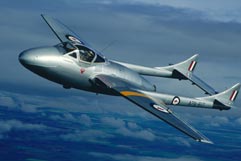 was planned where I was required
to fly in a Vampire with Geoff Trappett. I wasn’t impressed when I had
to do the ejector seat training and realised that if I had to bang out I
would probably die of fright. I had asked the trainer what I would do if
the seat did not automatically detach itself from me. His explanation of
the procedure in such a case left me with little confidence of survival.
was planned where I was required
to fly in a Vampire with Geoff Trappett. I wasn’t impressed when I had
to do the ejector seat training and realised that if I had to bang out I
would probably die of fright. I had asked the trainer what I would do if
the seat did not automatically detach itself from me. His explanation of
the procedure in such a case left me with little confidence of survival.
I noted when watching the SBS TV program ‘Real Top
Guns’, an experienced pilot stating that the ejector seat was there to
save your life, and injury might still result. He said that in some cases
the pilot who had ejected might be a couple of inches shorter for some
time and some were deemed medically unfit to fly again. Good grief!
I really enjoyed my time at Radschool.
I have to say that although I made a lot of friends amongst the education
officers. These included Bob Hunter, Ken Scott, Sam
Gamalatge, Greg Knott, John Hurley and Richard Jones. The greatest help
and support came from the radio officers and Radtechs. I remember such
guys as Flt Lt’s Jack Saunderson, Arthur Ellem, Arthur Gentle, John
Townsend, Flt Sgt Ivan Spiller, Sgt Nick Carter, Cpl Stan Buswell who were
all a great help to me. There was also a red headed WO in exam flight,
Blue someone, who was also great. I was very young (in fact, I was the
youngest EdO in the RAAF) and some of the students were older than me, but
I feel that it was some of the best and most rewarding teaching I ever
did.
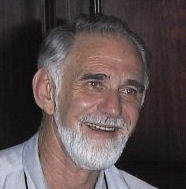 Figuratively Speaking
Figuratively Speaking

 and the thing taxis with two airmen walking alongside the outrigger
wheels. At the threshold of the runway, the airmen take the outriggers
off and hold a wingtip each. Full power, brakes off and the two airmen
run like hell holding the wingtips until it can be kept straight and
level. And then it just spirals straight up and disappears. About 5
hours later the U-2 returns. They had no fuel gauges and so the pilot
had to distribute fuel from each wing by feel and balance. Because they
are gliders they are actually difficult to get back down after the fuel
tanks are depleted. The pilot has no downward and very little forward
vision and necessitates another U-2 pilot in the control tower to ‘talk
him down’. Remember, no wheels on the wings. These crème de la crème
pilots were able to land the aircraft, taxi it to dispersal and a wing
tip would slowly drop to the ground. Hence the need to balance the fuel
use.
and the thing taxis with two airmen walking alongside the outrigger
wheels. At the threshold of the runway, the airmen take the outriggers
off and hold a wingtip each. Full power, brakes off and the two airmen
run like hell holding the wingtips until it can be kept straight and
level. And then it just spirals straight up and disappears. About 5
hours later the U-2 returns. They had no fuel gauges and so the pilot
had to distribute fuel from each wing by feel and balance. Because they
are gliders they are actually difficult to get back down after the fuel
tanks are depleted. The pilot has no downward and very little forward
vision and necessitates another U-2 pilot in the control tower to ‘talk
him down’. Remember, no wheels on the wings. These crème de la crème
pilots were able to land the aircraft, taxi it to dispersal and a wing
tip would slowly drop to the ground. Hence the need to balance the fuel
use. At one
period there seemed to be a bunch of new guys who were a bit of trouble
and it was rumoured that they had connections with some crims in
Melbourne. I appointed their ‘leader’ as block orderly. Never again did
I have to use the word ‘re-panic’! My worst moment was having to do a
kit inspection of a troop who had been complained about. He apparently
wasn’t washing himself or his clothes. I was embarrassed.
At one
period there seemed to be a bunch of new guys who were a bit of trouble
and it was rumoured that they had connections with some crims in
Melbourne. I appointed their ‘leader’ as block orderly. Never again did
I have to use the word ‘re-panic’! My worst moment was having to do a
kit inspection of a troop who had been complained about. He apparently
wasn’t washing himself or his clothes. I was embarrassed. OO. One night in the mess,
phone rings, steward answers it and calls ‘Orderly Officer’, take the
phone. A lady is complaining about the sonic booms over her farm because
the sound is upsetting the chooks, the cows and her husband, in that
order. As luck would have it, a test pilot was drinking next to where I
was standing ‘I think this is for you’ says I. Hand him the phone and
listen to a cock and bull story about the defence of the nation and
patriotism. It seemed to do the trick. The only advantage the OO got was
the special treatment from the stewards and mess staff. There are
strange rules in the mess, such as coffee must be consumed in the
ante-room, never in the dining room. Except for the OO, who had his
coffee brought to him by a steward.
OO. One night in the mess,
phone rings, steward answers it and calls ‘Orderly Officer’, take the
phone. A lady is complaining about the sonic booms over her farm because
the sound is upsetting the chooks, the cows and her husband, in that
order. As luck would have it, a test pilot was drinking next to where I
was standing ‘I think this is for you’ says I. Hand him the phone and
listen to a cock and bull story about the defence of the nation and
patriotism. It seemed to do the trick. The only advantage the OO got was
the special treatment from the stewards and mess staff. There are
strange rules in the mess, such as coffee must be consumed in the
ante-room, never in the dining room. Except for the OO, who had his
coffee brought to him by a steward.